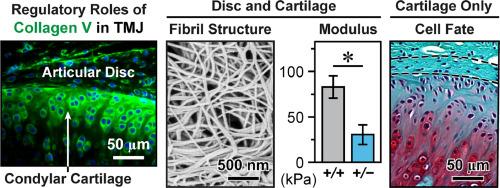V 型胶原蛋白在颞下颌关节关节盘和髁状突软骨出生后的生长和重塑过程中表现出不同的调节活性。
IF 9.4
1区 医学
Q1 ENGINEERING, BIOMEDICAL
引用次数: 0
摘要
了解调控颞下颌关节(TMJ)髁状软骨和关节盘出生后生长和重塑的基质分子活动将有助于开发针对颞下颌关节疾病的有效再生策略。本研究阐明了 V 型胶原(Collagen V)在调节这两个单元中的不同作用。在研究年轻成年 Col5a1+/- 小鼠的颞下颌关节时,我们发现 V 型胶原蛋白的缺失导致髁状软骨中祖细胞的增殖、聚集和密度发生了重大变化,但对更像成纤维细胞的椎间盘细胞并无重大影响。虽然胶原蛋白V的缺失导致椎间盘内胶原纤维增粗,异质性增加,但除了下侧后端微模量减少外,局部微模量没有明显变化。通过单侧前交叉咬合(UAC)手术诱导异常咬合负荷后,野生型(WT)和Col5a1+/-髁状突软骨都表现出明显的重塑,Col5a1+/-髁状突在后端的退化和肥大比WT更明显。相比之下,UAC和胶原V的缺乏都不会引起椎间盘形态或机械性能的明显变化。总之,我们的研究结果突显了胶原蛋白 V 在调节这两个单位在出生后生长和重塑过程中的不同作用,强调了它在髁状突软骨中更关键的作用,因为它对高度机械敏感的祖细胞有影响。因此,研究结果为利用胶原蛋白 V 改善颞下颌关节的再生和颞下颌关节疾病患者的护理奠定了基础。意义说明:由于对调节这些组织形成和重塑的基质分子活性了解有限,颞下颌关节(TMJ)髁状软骨和关节盘的成功再生仍是一项重大挑战。本研究表明,胶原蛋白 V 在这些过程中发挥着独特而关键的作用。在髁突软骨中,胶原蛋白V对调节祖细胞命运和维持基质完整性至关重要。在椎间盘中,胶原蛋白V还能调节纤维结构和局部微观力学,但对细胞表型或重塑反应的影响有限。我们的研究结果表明,胶原蛋白V是维持这两个单位完整性的关键成分,由于其对祖细胞活动的影响,在髁状突软骨中的作用更为关键。本文章由计算机程序翻译,如有差异,请以英文原文为准。

Type V collagen exhibits distinct regulatory activities in TMJ articular disc versus condylar cartilage during postnatal growth and remodeling
Understanding matrix molecular activities that regulate the postnatal growth and remodeling of the temporomandibular joint (TMJ) articular disc and condylar cartilage will enable the development of effective regenerative strategies targeting TMJ disorders. This study elucidated the distinct roles of type V collagen (collagen V) in regulating these two units. Studying the TMJ of young adult Col5a1+/− mice, we found that loss of collagen V resulted in substantial changes in the proliferation, clustering and density of progenitors in condylar cartilage, but did not have a major impact on disc cells that are more fibroblast-like. Although loss of collagen V led to thickened collagen fibrils with increased heterogeneity in the disc, there were no significant changes in local micromodulus, except for a reduction at the posterior end of the inferior side. Following the induction of aberrant occlusal loading by the unilateral anterior crossbite (UAC) procedure, both wild-type (WT) and Col5a1+/− condylar cartilage exhibited salient remodeling, and Col5a1+/− condyle developed more pronounced degeneration and tissue hypertrophy at the posterior end than the WT. In contrast, neither UAC nor collagen V deficiency induced marked changes in the morphology or biomechanical properties of the disc. Together, our findings highlight the distinct roles of collagen V in regulating these two units during postnatal growth and remodeling, emphasizing its more crucial role in condylar cartilage due to its impact on the highly mechanosensitive progenitors. These results provide the foundation for using collagen V to improve the regeneration of TMJ and the care of patients with TMJ disorders.
Statement of significance
Successful regeneration of the temporomandibular joint (TMJ) articular disc and condylar cartilage remains a significant challenge due to the limited understanding of matrix molecular activities that regulate the formation and remodeling of these tissues. This study demonstrates that collagen V plays distinct and critical roles in these processes. In condylar cartilage, collagen V is essential for regulating progenitor cell fate and maintaining matrix integrity. In the disc, collagen V also regulates fibril structure and local micromechanics, but has a limited impact on cell phenotype or its remodeling response. Our findings establish collagen V as a key component in maintaining the integrity of these two units, with a more crucial role in condylar cartilage due to its impact on progenitor cell activities.
求助全文
通过发布文献求助,成功后即可免费获取论文全文。
去求助
来源期刊

Acta Biomaterialia
工程技术-材料科学:生物材料
CiteScore
16.80
自引率
3.10%
发文量
776
审稿时长
30 days
期刊介绍:
Acta Biomaterialia is a monthly peer-reviewed scientific journal published by Elsevier. The journal was established in January 2005. The editor-in-chief is W.R. Wagner (University of Pittsburgh). The journal covers research in biomaterials science, including the interrelationship of biomaterial structure and function from macroscale to nanoscale. Topical coverage includes biomedical and biocompatible materials.
 求助内容:
求助内容: 应助结果提醒方式:
应助结果提醒方式:


